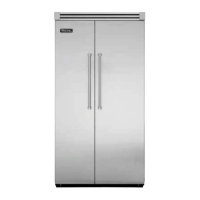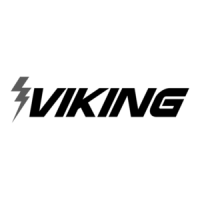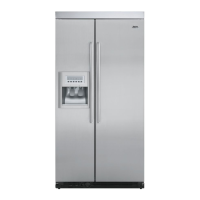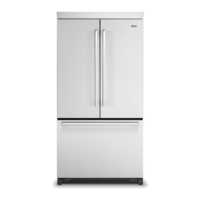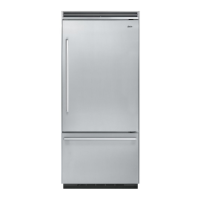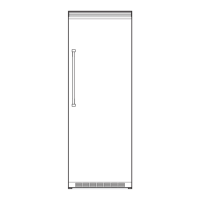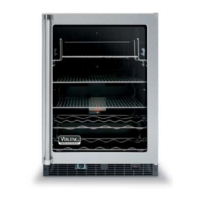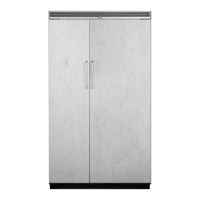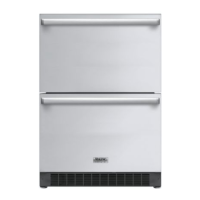Do you have a question about the Viking DDSB483D and is the answer not in the manual?
Electrical safety warnings and precautions for handling refrigerant.
Key specifications for the VCSB483D# model, including capacity and dimensions.
Detailed specifications for the Variable Capacity Compressor (VCC).
Description of OFF, H, and E states for the VCC control signal.
Precautions for using R134a refrigerant and avoiding contamination.
Guidelines for handling refrigerant exposure and safety.
Cautionary advice on treating refrigerant and what not to do when handling it.
Instructions for flushing eyes and skin after refrigerant contact and first aid.
Proper handling and precautions for liquid refrigerant tanks.
Description and function of an electronic charging scale.
Details on the setup for charging hoses and adapters.
Setup for purging sealed systems using hoses and a tee fitting.
Use of bubble solution or electronic leak detectors.
Use of a heat gun for heating components during service.
Types of silver brazing alloys and their applications.
Application of heat trap paste for component protection.
Use of sanding cloth for cleaning tubing before brazing.
Warning regarding fire risk and air contamination in sealed systems.
Equipment setup and step-by-step guide for evacuating the refrigeration system.
Notes on refrigerant usage, warranty, and access valves.
Step-by-step instructions for charging the refrigeration system.
Overview of the display panel buttons and temperature indicators.
Using pads to set freezer and refrigerator temperatures.
Location and function of power disconnect and showroom switches.
Description of Power Up, Door Open, and High Temperature alarms.
How thermistors affect temperature control and trigger alarms.
Explanation of how the adaptive defrost cycle works.
Steps to access Program Mode A and B.
Adjusting door alarm delay and max run times in Mode B.
Adjusting temperature offsets for freezer and refrigerator.
Steps for forced defrost start and forced compressor start.
Testing defrost heater and terminator circuits.
Checking compressor, condenser fan, and evaporator fan circuits.
Checking compressor, fan motor, and defrost heater relay states.
Checking defrost heater and terminator states.
Adapter board signal frequency to the inverter and control unit.
Relationship between motor speed and frequency input.
How freezer thermistor changes affect control signals and motor operation.
How the fresh food fan circulates air based on thermistor readings.
Step-by-step process for starting the compressor.
How the compressor operates under speed control input.
Detailed built-in protections performed by the inverter.
Flowchart for unit start-up based on defrost and frequency signal.
Flowchart for normal operation based on duty cycle and runtime.
How the control board signals the compressor via the adapter board.
Diagnostic steps for compressor start failures.
Verifying voltage supply and frequency signal.
Troubleshooting low signal voltage or incorrect frequency.
Finding and correcting restrictions causing high load.
Safety instructions for operating the ice and water dispenser.
Selecting ice modes, dispensing ice, and handling 'snow'.
Steps for the initial installation of the water filter cartridge.
Warnings and cautions regarding water quality and filter replacement.
Warnings about property damage and water pressure.
Connecting the saddle valve and copper tubing.
Procedures for testing ice maker power, thermostat, and motor.
How freezer temperatures affect ice production and cycling.
Description of the ice maker water valve and its function.
Electrical safety warnings and precautions for handling refrigerant.
Key specifications for the VCSB483D# model, including capacity and dimensions.
Detailed specifications for the Variable Capacity Compressor (VCC).
Description of OFF, H, and E states for the VCC control signal.
Precautions for using R134a refrigerant and avoiding contamination.
Guidelines for handling refrigerant exposure and safety.
Cautionary advice on treating refrigerant and what not to do when handling it.
Instructions for flushing eyes and skin after refrigerant contact and first aid.
Proper handling and precautions for liquid refrigerant tanks.
Description and function of an electronic charging scale.
Details on the setup for charging hoses and adapters.
Setup for purging sealed systems using hoses and a tee fitting.
Use of bubble solution or electronic leak detectors.
Use of a heat gun for heating components during service.
Types of silver brazing alloys and their applications.
Application of heat trap paste for component protection.
Use of sanding cloth for cleaning tubing before brazing.
Warning regarding fire risk and air contamination in sealed systems.
Equipment setup and step-by-step guide for evacuating the refrigeration system.
Notes on refrigerant usage, warranty, and access valves.
Step-by-step instructions for charging the refrigeration system.
Overview of the display panel buttons and temperature indicators.
Using pads to set freezer and refrigerator temperatures.
Location and function of power disconnect and showroom switches.
Description of Power Up, Door Open, and High Temperature alarms.
How thermistors affect temperature control and trigger alarms.
Explanation of how the adaptive defrost cycle works.
Steps to access Program Mode A and B.
Adjusting door alarm delay and max run times in Mode B.
Adjusting temperature offsets for freezer and refrigerator.
Steps for forced defrost start and forced compressor start.
Testing defrost heater and terminator circuits.
Checking compressor, condenser fan, and evaporator fan circuits.
Checking compressor, fan motor, and defrost heater relay states.
Checking defrost heater and terminator states.
Adapter board signal frequency to the inverter and control unit.
Relationship between motor speed and frequency input.
How freezer thermistor changes affect control signals and motor operation.
How the fresh food fan circulates air based on thermistor readings.
Step-by-step process for starting the compressor.
How the compressor operates under speed control input.
Detailed built-in protections performed by the inverter.
Flowchart for unit start-up based on defrost and frequency signal.
Flowchart for normal operation based on duty cycle and runtime.
How the control board signals the compressor via the adapter board.
Diagnostic steps for compressor start failures.
Verifying voltage supply and frequency signal.
Troubleshooting low signal voltage or incorrect frequency.
Finding and correcting restrictions causing high load.
Safety instructions for operating the ice and water dispenser.
Selecting ice modes, dispensing ice, and handling 'snow'.
Steps for the initial installation of the water filter cartridge.
Warnings and cautions regarding water quality and filter replacement.
Warnings about property damage and water pressure.
Connecting the saddle valve and copper tubing.
Procedures for testing ice maker power, thermostat, and motor.
How freezer temperatures affect ice production and cycling.
Description of the ice maker water valve and its function.
| Brand | Viking |
|---|---|
| Model | DDSB483D |
| Category | Refrigerator |
| Finish | Stainless Steel |
| Energy Star Certified | Yes |
| Ice Maker | Yes |
| Water Dispenser | Yes |
| Defrost Type | Automatic |
| Door Finish | Stainless Steel |
| Type | Side-by-Side |
| Width | 48 inches |
| Height | 84 inches |
